A disorderly Greek default has been headed off but the euro zone remains the powder keg of the global economy. While fears for Greece’s public finances are still running high, European leaders managed to contain the damage in that fears for other troubled countries of the zone have abated somewhat.
Preliminary data confirm that the economy of the zone shrank in Q4, modestly but on an ominously broad front. Outside the euro zone, the Japanese economy is also labouring. In this time of uncertainty, the good news is that other growth centres have taken up the slack. The decoupling is a heartening sign.
Athens and euro-zone governments have reached agreement on a €130 billion bailout for Greece after weeks of talks to avoid a March default. Under this plan, private lenders accept a 53.5% haircut and Athens has accepted the presence in the country of a permanent team to monitor the measures required by the plan. At this writing the agreement must still be ratified by the Finnish and German parliaments by the end of February. In our view, however, the much greater hurdle for management of the crisis is a possible Greek parliamentary election in April.
The country’s economy is entering a fourth year of recession. The contraction has accelerated over the past three years as a result of austerity measures adopted in haste to restore the country’s public finances. In each year since 2007 the economy has performed below the forecasts of the IMF, which is also a leading player in the bailout. This history makes it easier to understand the patient’s reluctance to swallow the pill put before it. By 2020, under the plan, Greece’s debt will subside to 120% of GDP, still very high. At an interest rate of 6% – an optimistic number – debt service will eat 7.2% of Greece’s GDP, more than for any other defaulting country over the last 15 years. It would be hardly surprising if Greek voters were to go for another option in the medium term.
Market fears for troubled euro-zone countries other than Greece have abated recently, as measured by the likelihood of default implied by default-swap prices. We are happy to see this abatement because financing spreads for financial institutions have also narrowed recently, a prerequisite for the recession not becoming a credit crisis.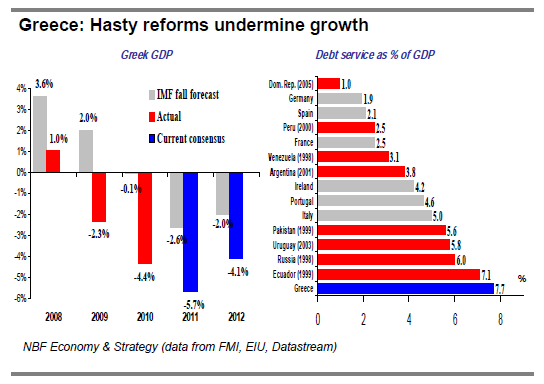
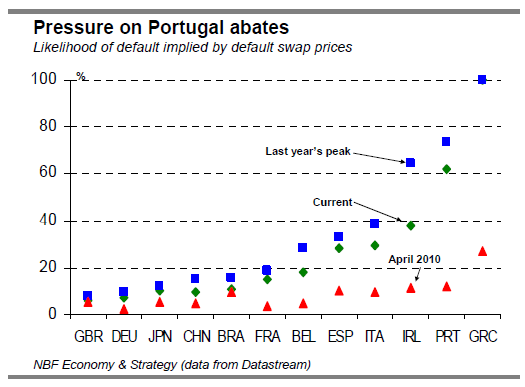
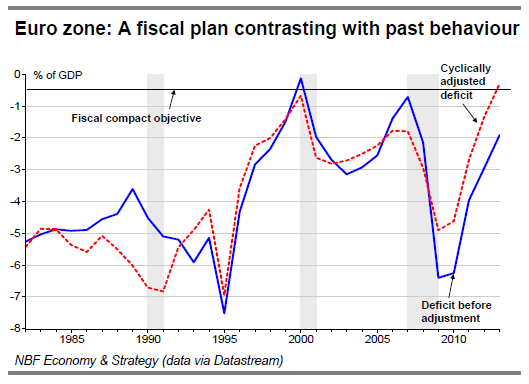
We are also happy to see that the euro countries have agreed to reinforce their fiscal discipline. Under the new agreement, a member country must keep any structural deficit (deficit adjusted for cyclical swings) within 0.5% of GDP, on pain of financial sanctions. By way of comparison, the average deficit of the euro countries would have complied with this rule in none of the last 30 years.
Preliminary data have confirmed that, as widely thought, the euro-zone economy shrank in the fourth quarter. True, the contraction of 1.3% annualized was less than the consensus expectation of 1.6%, thanks to a French surprise of 0.8% growth, but it was broadbased. GDP declined in eight of the 11 euro countries reporting so far (assuming that Greece is again contracting). While the euro zone surprised on the upside, Japan disappointed. Its 2.3% contraction was considerably worse than the anticipated 1.3%. Apart from flooding in Thailand that temporarily crimped exports, the result can be laid to the strength of the yen combined with the weakness of foreign demand.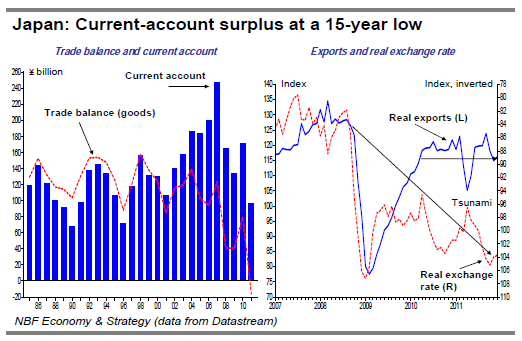
As the euro zone and Japan languished, other growth centres took up the slack. The latest CPB report shows world industrial production up 0.6% in Q4 despite declines of 1.3% in the euro zone and 0.2% in Japan, which taken together account for 23% of the global total. The offsetting contributors include the U.S. and the emerging economies. The net result was record world industrial production in December. Even more encouraging was an all-time high in global trade, signalling that the output was finding takers.
Other recent indicators support an optimistic outlook. The JPMorgan global purchasing manager surveys show an economic acceleration in January. The composite index rose for a third straight month, to an 11-month high of 54.6. The services index rose to 55.4 from 53 and the manufacturing index to 51.2 from 50.5. The new orders index rose to 54.0 from 51.5, the largest increase in 10 months.
The European cloud in the global economic sky has been joined recently by a run-up in the price of oil. Fresh in memory is the effect on economic growth in 2010 and 2011 of soaring staple prices, which household incomes could not keep up with in many countries. A geopolitical risk premium that swells the price of crude, currently due to uncertainty surrounding Iran, acts like a consumption tax. This time, however, in contrast to last year, it is the energy bill alone that is cause for concern, not food prices as well. A sharp decline of grain prices in recent months can be expected to show up eventually in household food bills.
A number of central banks, worried much more about economic growth than inflation these days, have acted to stimulate their economies. In our view, the U.S. revival and China’s pursuit of a soft landing are likely to offset European weakness in 2012. We continue to expect world GDP growth on the order of 3.4% this year.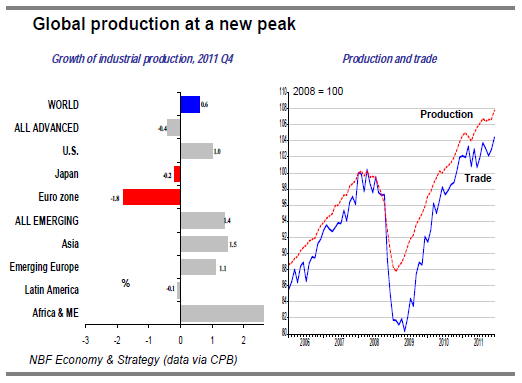
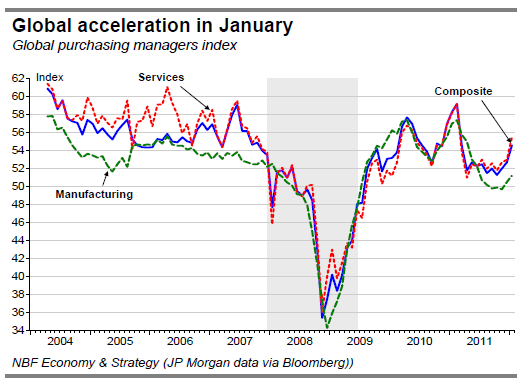

U.S.: Employment Surges
The year 2012 started rather well in the U.S., with a very strong January employment report and healthy economic readings for February as well. Odds are that those numbers carry momentum. Consumers seem more upbeat, housing seems to be stabilizing and exports remain resilient in the face of the European recession. These indicators point to healthy U.S. growth in Q1 and through much of the year.
Momentum from a good final quarter of 2011 carried into the new year as we had expected. Both the New York Fed and Philly Fed indexes of manufacturing activity reached multi-month highs in February, while industrial production remains supportive of our call on Q1 GDP growth – about 2% annualized.
The labour market shocked on the upside in January. The nonfarm payrolls survey reported a monthly net gain of well over 200,000 jobs, all in the private sector. And upward revisions to 2011 data showed a labour market in much better shape than previously thought – 2.2 million new private-sector jobs last year instead of the previously estimated 1.9 million. Interestingly, recent hiring has been particularly strong in industries where men figure more prominently in the workforce. Cyclical industries such as manufacturing, mining & logging, transportation & warehousing and construction added 94,000 jobs in January, one of the best gains so far in this cycle. That pushed the male jobless rate down significantly to 8.3%, matching the female jobless rate for the first time since October 2006. The resulting 8.3% overall unemployment rate is the lowest in three years. Odds are that the labour market will maintain momentum. Note that initial jobless claims sank to a 4- year low in February.
Better job prospects are boosting consumer confidence and that’s translating into increased spending. Real retail spending has indeed risen at an annualized pace of 7.5% since consumer sentiment hit a trough back in August (which coincided with the debt-ceiling fiasco). That’s the strongest five-month increase in volume retail sales since June 2010. Real retail sales growth is tracking 2.4% annualized in Q1, consistent with moderating but still healthy GDP growth. Discretionary spending – retail sales excluding gasoline, groceries and health/personal care – has been rising for eight straight months. The extension of payroll tax cuts to the end of this year, the takeoff of the labour market and the apparent stabilization of the housing market are good news for confidence and hence supportive of consumer spending this year.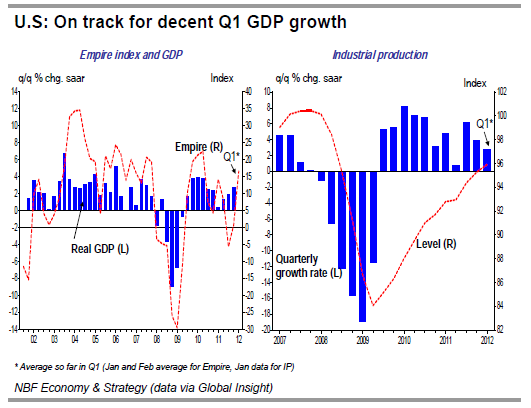
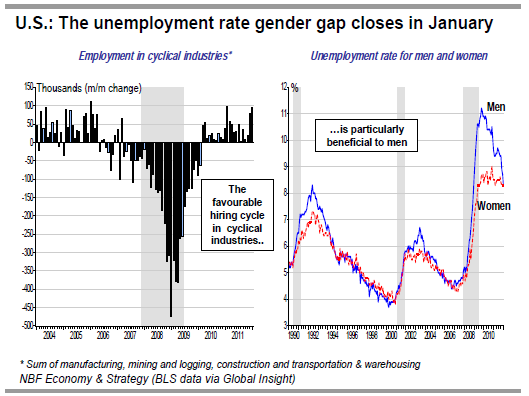

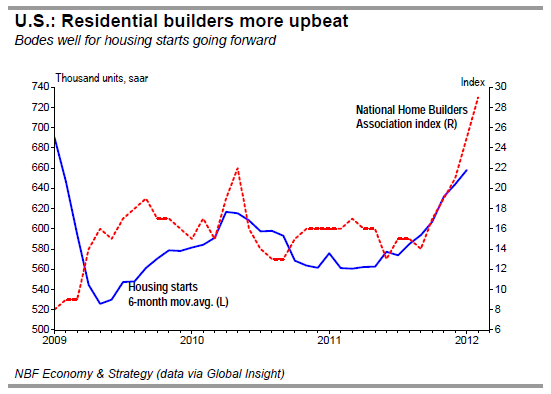
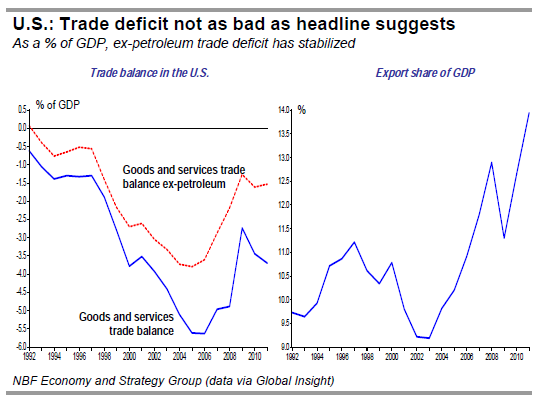

Besides boosting consumer confidence, a more stable housing market is also propping up economic activity in the construction sector. While housing starts remain at historically depressed levels, they are nonetheless ramping up slowly. The rise of the NAHB’s homebuilder confidence index to a 57-month high in February, points to a possible turnaround of the housing market. Recordlow interest rates, better credit availability and an everimproving labour market all bode well for residential construction. That said home prices are likely to remain subdued as stronger demand is offset by new supply from foreclosures and construction.
While domestic demand remains in relatively good shape, trade is also performing reasonably well. True, in 2011 the trade deficit rose to $558 bn or 3.7% of GDP, a three-year high. But the worsening U.S. trade balance is primarily due to its oil imports. Much of the deterioration over the past couple of years has been due primarily to imports of oil, whose price has risen more than 50% in that period. Excluding petroleum, the trade deficit has stabilized at 1.5% of GDP. This more sustainable trade picture is largely due to strong export growth. Over the past couple of years, exports have grown 34% allowing its share of GDP to reach 13.9% in 2011, the highest on record. While the European recession will limit export growth this year, the damage is likely to be minimal given that the share of U.S. goods and services going to Europe is now at a record low. Healthy demand from emerging markets and Asia in general, should continue to power American exporters. With trade growing in importance for the U.S. economy, expect Washington to maintain its “not so strong” USD policy.
While the Fed may not admit to it, its ultra loose monetary policy is essentially killing two birds with one stone, stimulating domestic demand but also supporting export competitiveness via a cheaper currency. Recent injections of liquidity by the ECB and BoJ have taken some steam out of the euro and yen and boosted the US dollar in the process. But the money printing battle isn’t over yet. QE3 remains an option for the Fed, particularly with some members of the FOMC going on record as saying that additional securities purchases could be warranted “before long”. That said, don’t expect QE3 to be dispatched for now, not just because the U.S. keeps churning out consensus-topping economic data, but also because of resilience in core prices and a PCE deflator that’s still above the Fed’s stated 2% target.
Canada: Trade makes comeback
Trade linkages with the world’s largest economy played in Canada’s favour in the final quarter of last year as exporters reaped the benefits of a U.S economy on the ascendancy. That, however, didn’t prevent a moderation in Q4 GDP – a cooling was always in the cards after a very strong third quarter. Data for early 2012 are sending mixed messages at this point, with consumer spending seeming to defy prolonged sluggishness in the labour market, very much as in the last quarter of 2011.
At this writing, Q4 GDP growth wasn’t yet available, but monthly data suggest a reading of roughly 2% annualized for the quarter, not a bad performance particularly after a white hot third quarter.
The labour market sluggishness in the final quarter of last year carried over into 2012 with January’s flat employment causing the unemployment rate to climb to 7.6%, the highest in nine months. Hours worke contracted in Q4 for the first time since the recession although January data suggests some minor improvement on that front. Though the employment numbers are generally weak, they are not in recession territory. Cumulative job creation over the most recent three months, while not stellar, is well into positive territory. Moreover, the private sector created jobs for the third consecutive month in January, a sign that there’s still plenty of life in the Canadian labour market.
Despite tepid employment reports, consumers have ramped up spending. Retail volumes in Q4 in fact grew at the highest quarterly pace of the year. Spending on durables was particularly strong in Q4 – unit auto sales soared 9% annualized in a quarter that was supposedly jobs-challenged. Domestic demand seems to have remained in good shape in early 2012 too, if Statistics Canada’s preliminary estimate of January unit auto sales is any guide. If the reported 16% monthly increase really materialized, that would put January unit auto sales at a four-year high of 154,400. Also supporting domestic demand somewhat in Q4 was business investment spending which seemed to
stabilized after slumping in the third quarter. The fundamentals there are solid. Corporate cash positions and profits are healthy, and the strong currency cheapens equipment imports. Raising productivity is a necessity in an environment of parity exchange rates with the US dollar, and buying machinery and equipment is a good way of achieving that crucial objective.
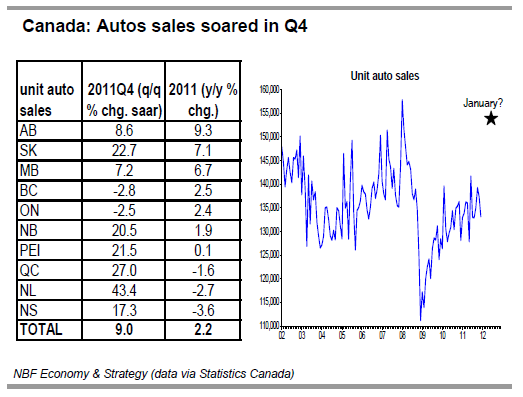
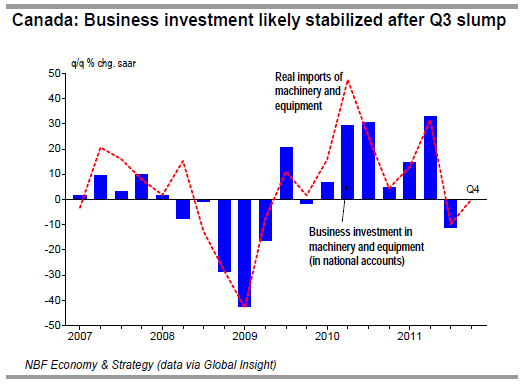
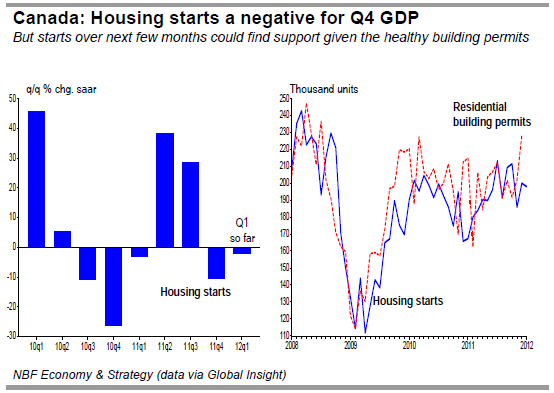
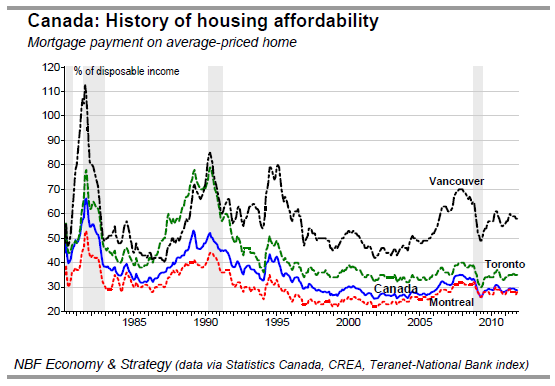
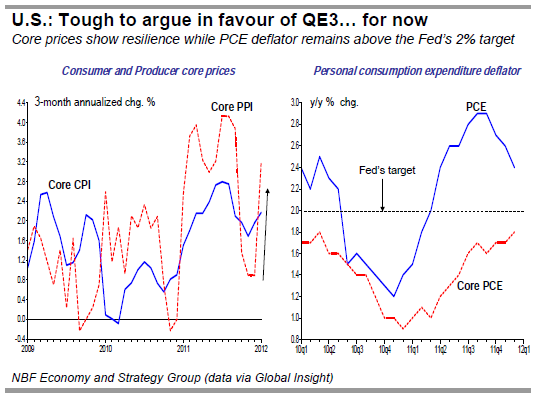
Residential construction likely weighed a bit on Q4 GDP if housing starts are any guide. Starts indeed contracted at an annualized pace of 10.5% in that quarter, and January results suggest that weakness carried over into 2012. The relatively strong building permit applications point to a possible recovery in starts later in Q1. But recent trends suggest that the much-anticipated softening in the Canadian housing market may finally have arrived.
While we also subscribe to the notion that the housing boom is over, we’re less pessimistic than those who forecast a sharp correction in prices. True, home prices have climbed to nose bleed levels and the oftmentioned household debt is elevated. But then again, interest rates are very low, which makes servicing of that debt manageable. Home affordability – mortgage payments as a percentage of disposable income – seems roughly in line with historical norms in most Canadian cities.
Consequently, provided that the Canadian economic expansion is not undermined by a global credit crisis, an imminent house price correction is rather unlikely - for more information see our Weekly Economic Letter, February 20th 2012: “Are fears concerning imminent drop in house prices in Canada overblown?”.
Trade, which started Q4 rather poorly, made a spectacular comeback in December, so much so that it’s now likely to be a contributor to GDP in that quarter. The revival of the U.S. economy is for now helping Canadian exporters deal with the headwinds generated by the strong currency. Volume exports rose 7% annualized in Q4, led by energy, agriculture, industrial goods and materials and, especially, automotive exports, whose 44.5% growth rate was driven by a surge in U.S. auto assemblies.
Odds are that this uptrend extended into early 2012, since U.S. auto assemblies, after growing 23.5% annualized in Q4, are tracking 59% in Q1 on the basis of a strong January. While there’s still a long way to go for Canadian auto exports to return to pre-recession levels, expect the auto sector recovery to continue this year. More broadly, trade is likely to contribute to Canadian GDP in 2012 thanks to better U.S. economic activity.
- English (UK)
- English (India)
- English (Canada)
- English (Australia)
- English (South Africa)
- English (Philippines)
- English (Nigeria)
- Deutsch
- Español (España)
- Español (México)
- Français
- Italiano
- Nederlands
- Português (Portugal)
- Polski
- Português (Brasil)
- Русский
- Türkçe
- العربية
- Ελληνικά
- Svenska
- Suomi
- עברית
- 日本語
- 한국어
- 简体中文
- 繁體中文
- Bahasa Indonesia
- Bahasa Melayu
- ไทย
- Tiếng Việt
- हिंदी
World: The Decoupling Begins
Published 02/28/2012, 06:18 AM
Updated 05/14/2017, 06:45 AM
World: The Decoupling Begins
Latest comments
Loading next article…
Install Our App
Risk Disclosure: Trading in financial instruments and/or cryptocurrencies involves high risks including the risk of losing some, or all, of your investment amount, and may not be suitable for all investors. Prices of cryptocurrencies are extremely volatile and may be affected by external factors such as financial, regulatory or political events. Trading on margin increases the financial risks.
Before deciding to trade in financial instrument or cryptocurrencies you should be fully informed of the risks and costs associated with trading the financial markets, carefully consider your investment objectives, level of experience, and risk appetite, and seek professional advice where needed.
Fusion Media would like to remind you that the data contained in this website is not necessarily real-time nor accurate. The data and prices on the website are not necessarily provided by any market or exchange, but may be provided by market makers, and so prices may not be accurate and may differ from the actual price at any given market, meaning prices are indicative and not appropriate for trading purposes. Fusion Media and any provider of the data contained in this website will not accept liability for any loss or damage as a result of your trading, or your reliance on the information contained within this website.
It is prohibited to use, store, reproduce, display, modify, transmit or distribute the data contained in this website without the explicit prior written permission of Fusion Media and/or the data provider. All intellectual property rights are reserved by the providers and/or the exchange providing the data contained in this website.
Fusion Media may be compensated by the advertisers that appear on the website, based on your interaction with the advertisements or advertisers.
Before deciding to trade in financial instrument or cryptocurrencies you should be fully informed of the risks and costs associated with trading the financial markets, carefully consider your investment objectives, level of experience, and risk appetite, and seek professional advice where needed.
Fusion Media would like to remind you that the data contained in this website is not necessarily real-time nor accurate. The data and prices on the website are not necessarily provided by any market or exchange, but may be provided by market makers, and so prices may not be accurate and may differ from the actual price at any given market, meaning prices are indicative and not appropriate for trading purposes. Fusion Media and any provider of the data contained in this website will not accept liability for any loss or damage as a result of your trading, or your reliance on the information contained within this website.
It is prohibited to use, store, reproduce, display, modify, transmit or distribute the data contained in this website without the explicit prior written permission of Fusion Media and/or the data provider. All intellectual property rights are reserved by the providers and/or the exchange providing the data contained in this website.
Fusion Media may be compensated by the advertisers that appear on the website, based on your interaction with the advertisements or advertisers.
© 2007-2024 - Fusion Media Limited. All Rights Reserved.
